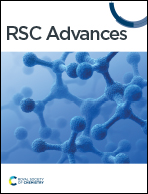Visible light driven reform of wasted plastics to generate green hydrogen over mesoporous ZnIn2S4†
Abstract
As the global consumption of plastics keeps increasing, the accumulated plastics in the natural environment have threatened the survival of human beings. Photoreforming, as a simple and low-energy way, could transform wasted plastic into fuel and small organic chemicals at ambient temperature. However, the previously reported photocatalysts have some drawbacks, such as low efficiency, containing precious or toxic metal. Herein, a noble-free, non-toxic, and easy prepared mesoporous ZnIn2S4 photocatalyst has been applied in photoreforming of polylactic acid (PLA), polyethylene terephthalate (PET) and polyurethane (PU), generating small organic chemicals and H2 fuel under simulated sunlight. Plastic was degraded into small organic molecules after the pretreatment, which futher acted as the substrate for photoreforming. Mesoporous ZnIn2S4 exhibits high H2 production efficiency, strong redox ability, and long-term photostability. Furthermore, mesoporous ZnIn2S4 could overcome the hindrances of dyes and additives of realistic wasted plastic bags and bottles with high decomposition efficiency, providing an efficient and sustainable strategy for the upcycling of wasted plastics.

- This article is part of the themed collection: Plastic Waste Utilisation: A cross-journal collection


 Please wait while we load your content...
Please wait while we load your content...